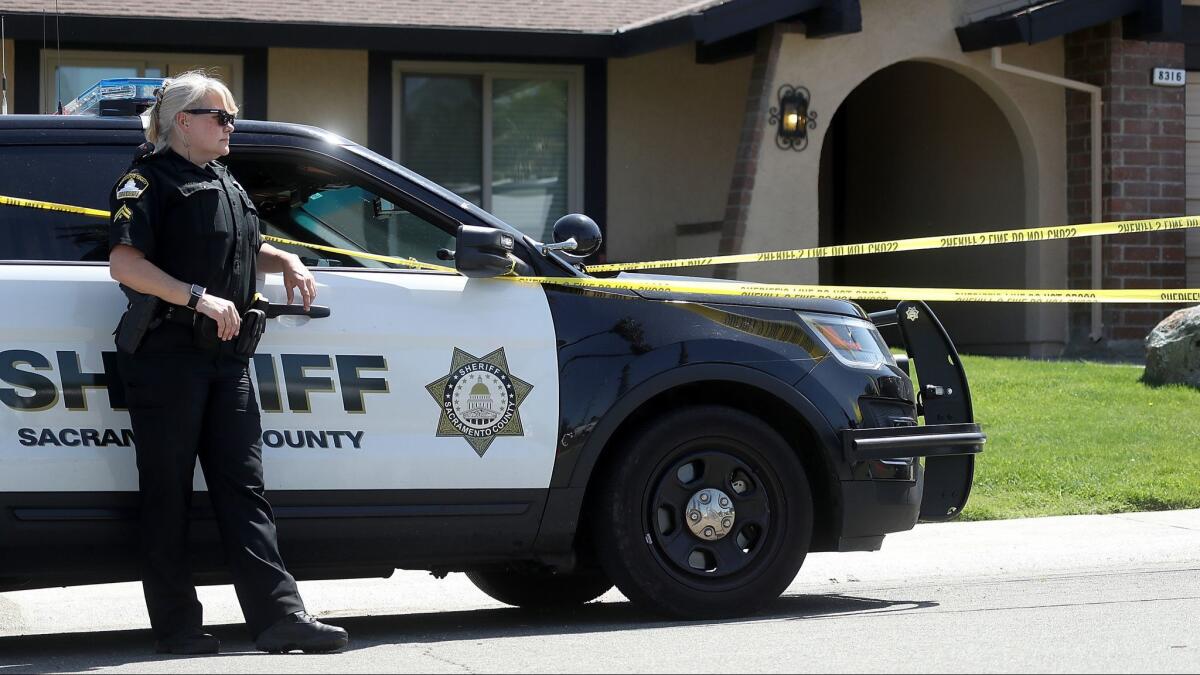Thousands of suspects, many dead ends: the quest for the Golden State Killer

- Share via
Larry Pool’s life mission was to track down the Original Night Stalker.
The retired Orange County sheriff’s investigator studied thousands of clues, kept a recording of the killer’s voice in his desk’s top drawer and once exhumed a body to collect a DNA sample.
He knew by heart the killer’s path. And his fervor was shared by countless others across California searching for a suspect who went by many names.
Around Sacramento, investigators knew him as the East Area Rapist, whose string of sexual assaults and killings began in 1976. Detectives in the San Joaquin Valley searched for the Visalia Ransacker, who plundered homes there from 1974 to 1975.
Along the Central Coast, authorities focused on double-killings in Goleta and Ventura in the early 1980s. In Orange County, Pool and others focused on the murders and rapes that continued until 1986.
DNA evidence had united many of these disparate crimes into a single but frustratingly cold trail for a suspect with a new nickname, the Golden State Killer. That is until Wednesday, when authorities finally put a face to that long-ago terror: Joseph James DeAngelo Jr.
For detectives, journalists and the true-crime obsessives who followed the Golden State Killer, the arrest and murder charges against DeAngelo, a former police officer, marked a shocking turn in a case that had haunted and driven them for four decades. It was also a moment of consolation for victims, their families and investigators such as Pool, who had a list of 8,000 suspects, none of them named DeAngelo.
“I breathed a sigh of relief when I found the offender had been ID’d. It’s a relief I haven’t felt ever,” Pool said. “Today, we know him by name — which is what we’ve been looking forward to for a long time.”
The “Golden State Killer” moniker was bestowed by the late true-crime author Michelle McNamara. Her work helped fan interest in the case, and investigators credited public awareness with leading to a flurry of tips.
It’s unclear how authorities zeroed in on DeAngelo, 72, who was arrested at his home in a Sacramento suburb. Officials would say only that the case relied on DNA. For years, crime labs had used a DNA profile of the Golden State Killer to evaluate — and rule out — suspects.
“In employing this technology, there was a link between the DNA that we had and the potential for examining a universe of folks, for which our guy was a member,” Sacramento County Sheriff Scott Jones said at a news conference.
Late Wednesday, Jones’ office confirmed that DeAngelo was a positive match for DNA from crimes by the East Area Rapist, the Original Night Stalker and the Golden State Killer, as well as a match for the methods used by the Visalia Ransacker. The culprit was known for taking jewelry and old coins, and using cups or plates on a victim’s body as an alarm system, threatening death if the person moved and unsettled the dishes.
Jason Salazar, Visalia’s police chief, said none of the Ransacker burglaries had DNA evidence, so their link to the wider series of crimes is less definitive.
“Although many believe, because of the modus operandi, that the Visalia Ransacker is where the Golden State Killer began committing his crimes. We believe that is also the case,” Salazar added.
Investigators used two DNA samples, each yielding a 100% match. Along with DNA, investigators also relied on extensive surveillance of DeAngelo, Jones said.
“We found the needle in the haystack and it was right here in Sacramento County,” Dist. Atty. Anne Marie Schubert said.
The potential for DNA to unlock the killer’s identity had long been recognized by investigators and the relatives of victims.
Bruce Harrington, whose brother Keith and sister-in-law Patrice were slain at their Dana Point home in 1980, allegedly by the Golden State Killer, helped bankroll the passage of Proposition 69 in 2004. The measure mandates that all felons and some people convicted of misdemeanors submit DNA samples to a state database, whose catalog has increased greatly and aided law enforcement in solving brutal crimes.
That year, Harrington told The Times, “It’s clear from my family’s point of view — my two brothers and myself — that the only realistic way we’re going to identify who killed Keith and Patti is through DNA technology.”
Almost four decades ago, a killer entered the home of Keith and Patrice Harrington, newlyweds with jobs in the medical field. They lived inside Niguel Shores, a gleaming gated community in then-unincorporated Orange County, now part of Dana Point.
Patrice Harrington had just finished a phone call with her sister. Shortly after 11 p.m. on Aug. 19, 1980, the suspect used a type of macrame cord and “blitzed Patrice,” Pool said. He bound the couple in their bedroom before taking her to another room, where, Pool said, the suspect sexually assaulted her.
Two days later, one of their fathers discovered the couple’s bludgeoned remains.
Pool last chatted with Bruce Harrington in 2004, when the brother told him, “Look, it’s not personal — I like you but I don’t want to talk to you again until you ID the offender.”
On Wednesday, Pool finally made the call.
Twitter: @newsterrier
Twitter: @MattHjourno
Times staff writers Joseph Serna in Los Angeles and John Myers in Sacramento contributed to this report.
More to Read
Sign up for Essential California
The most important California stories and recommendations in your inbox every morning.
You may occasionally receive promotional content from the Los Angeles Times.















